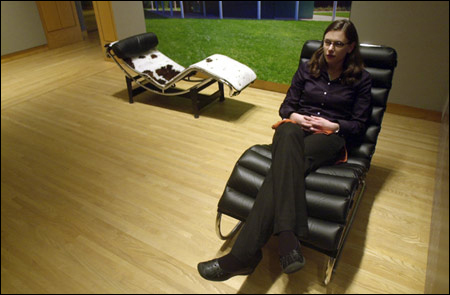Modernist design from a (very) relaxed vantage
‘Design/Recline: Modern Architecture and the Mid-Century Chaise Longue’ at the Busch-Reisinger Museum shows different side of architects

“The Ottoman Empire – what was that, an empire based on putting your feet up?”
– Jerry Seinfeld
It turns out that putting your feet up was also a significant part of modernist design, a fact that surprised Robin Schuldenfrei when she began looking closely at the work of such important 20th century designers as Le Corbusier, Marcel Breuer, Ludwig Mies van der Rohe, Walter Gropius, and others.
“I started wondering, why was it that all these important architects and designers were designing chairs for just lounging around?”
Schuldenfrei, a Ph.D. candidate in the Graduate School of Design (GSD), discovered that nearly all of these designers had created their own version of the chaise longue or “long chair,” a form that has existed since the 16th century in France but which enjoyed a resurgence during the 1920s and ’30s, the period when modernist art and design gained worldwide popularity.
So popular did the chaise longue become, especially in its 1950s and ’60s American incarnation as the mass-produced chaise lounge, that it is difficult to see these pieces today as the innovative designs they once were. The patronizing 21st century eye tends to dismiss them as outdated patio furniture.
Schuldenfrei started thinking about an exhibition that would defamiliarize the modernist chaise longue by presenting it in the context of the architecture with which it was originally associated. The result is “Design~Recline: Modern Architecture and the Mid-Century Chaise Longue,” now at the Busch-Reisinger Museum.
The exhibition presents nine actual chaises longues positioned in front of large photomurals of closely associated architecture. In most cases, the buildings are residential homes by the same architect who designed the chair, in other words, the ideal match between architecture and furniture. Most of the chairs are from the Harvard Art Museums or borrowed from other collections, but two – the Le Corbusier and Mies van der Rohe chairs – are reproductions purchased especially for the exhibition. And, yes, this means you can sit in them, or recline, as the case may be.
In French, the term chaise longue also denotes a deck chair, and in fact, much of the inspiration for these chairs, as well as for much of modern design, came from the 20th century ocean liner. The modernist era brought about a revolution in concepts of health as well as concepts of beauty. Under the influence of modern germ theory, people gave up older ideas that “bad air” by itself could cause disease. Exposure to the air became a healthy thing, especially on the deck of an ocean liner, and the chaise longue was the ideal piece of furniture for this activity.
The setting of the Le Corbusier chair emphasizes this idea. The chair with its

tubular steel frame and pony hide upholstery sits in front of the architect’s 1929-31 Villa Savoye, which, with its flat roof garden adorned with smokestack-like shapes, actually looks something like an oceangoing ship.
Another source for the chaise longue was the sanatorium where tuberculosis patients in pre-penicillin days convalesced by reclining on “cure porches,” exposed to sun and air. The exhibition includes an example of one of these chairs, designed in 1935 for the martel-de-Janville Sanatorium in Passy, France. A large black-and-white photo behind it shows the sanatorium in its mountain setting, its facade covered by reinforced concrete balconies, another new innovation at the time.
Part of the modernist agenda was that industrial materials and manufacturing techniques would put the new furniture within the reach of the masses, but this idea was rarely realized. Ludwig Mies van der Rohe’s elegant chaise longue with its one-piece steel frame and black leather cushion cost $87 to manufacture, an expensive item in 1931. Marcel Breuer’s 1934 aluminum chair was cheaper to build and had the added advantage of being light enough to drag outside when the weather was agreeable.
One point that Schuldenfrei wanted to make with this exhibition was that the objects these designers created did not always conform to what is considered modernist design philosophy. Alvar Aalto of Finland and Bruno Mathesson of Sweden both departed from the internationalist emphasis on industrial materials when they designed chairs with frames of bent wood covered with materials like woven jute and reindeer hide.
The work of the husband and wife team Charles and Ray Eames brought modernist design to middle-class America. The exhibition includes two of their chairs, the voluptuous molder fiberglass “La Chaise” of 1948 and the 1968 Billy Wilder chaise. The latter was designed expressly for the film director who claimed that the most comfortable place to rest was a board placed on two sawhorses. He also wanted a chair that could not be mistaken for a casting couch. The Eameses granted his wish by designing a narrow black leather chaise on a steel frame.
Seeing these historic pieces of furniture in the context of the houses for which they were designed puts them into a new perspective and puts the houses in a new perspective as well. It reminds us that, in Le Corbusier’s famous phrase, a house can indeed be seen as “a machine for living,” and that living involves not only sitting down, but occasionally putting your feet up.




